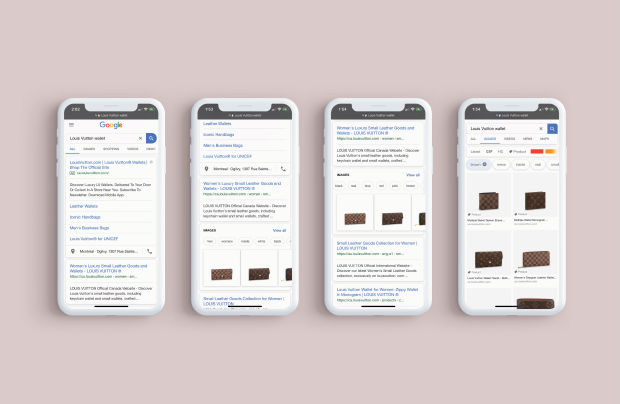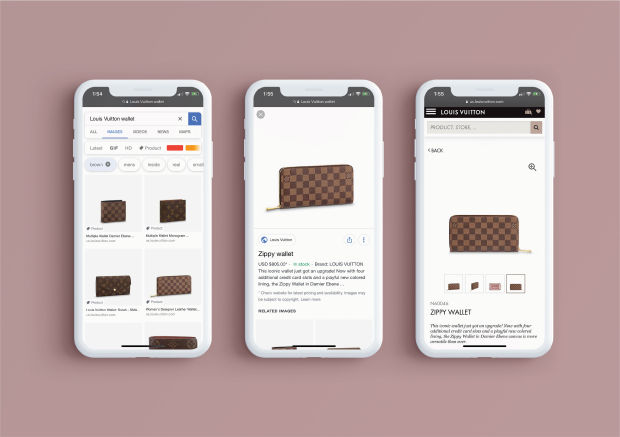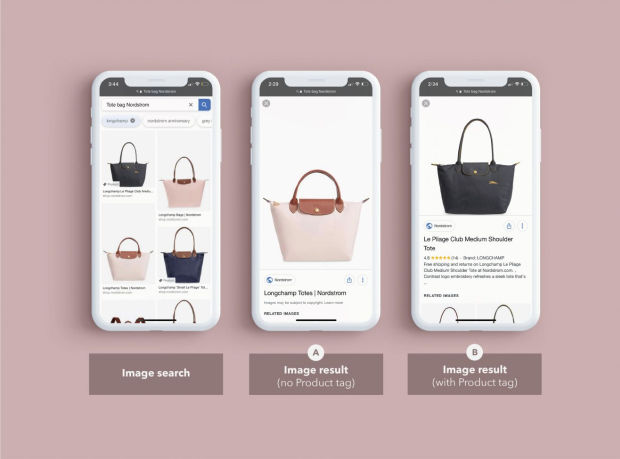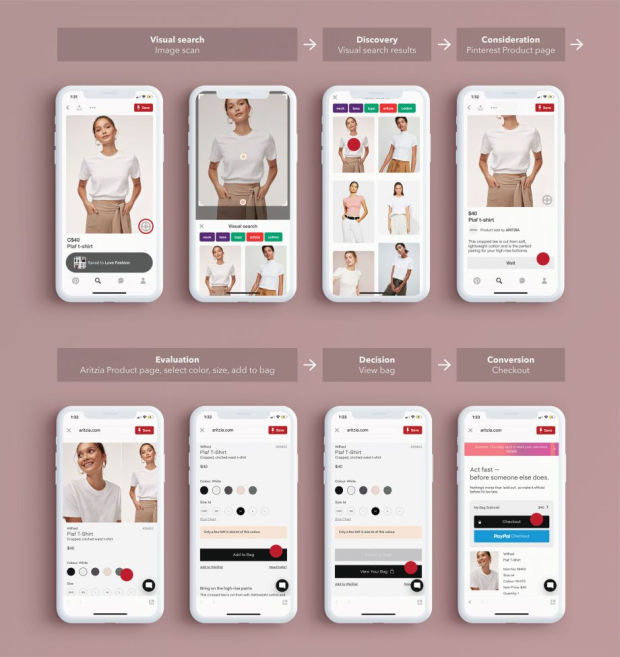
Visual Search Opportunities for eCommerce Brands

The emergence of image recognition technology provides retail marketers with new opportunities. Not only does it increase product discovery through visual search, but it has the potential to improve the overall customer experience, while increasing revenues.
So, how can marketers adapt their strategies to take advantage of this emerging technology? By optimising their image content for search engines and social media.
Google Image and Visual Search Optimisation
When searching for a branded product in Google on mobile, have you noticed that images sometimes appear directly in the results?
For example, when searching for a Louis Vuitton wallet: the second organic result – after the ad at the top and the Louis Vuitton website – is a carousel of images, which allows users to refine their search with category options. Even if this is the third result, it is more than likely that searchers will gravitate to those images.

85% of consumers place more importance on visuals than on text information when shopping online for clothing, according to a recent study by The Intent Lab (a research partnership between Performics, a performance marketing agency, and Northwestern University).
Using the Louis Vuitton wallet example, consider two scenarios:
When a searcher clicks on the image, they are directed to the Google Product page which lists the price and product information. With a second click, they are taken to the Louis Vuitton site to make a purchase, should they choose to do so.

When a searcher clicks on the URL, they land directly on the Louis Vuitton site, view the product page, select a color and potentially make a purchase.
In Google Image search, a user will only click through to the site if they click on the URL, or on the branded button below the image on the Google Product page.
What does this mean for marketers? By including product information on Google, it creates a frictionless environment where shoppers can make faster purchase decisions. However, if the searcher views the product on Google and then decides not to purchase it, that data will not be available as the user never made it to the brand’s website. Is the trade-off to provide a better customer experience worth it?
Google Images as Products
Here are two examples of Google Image results: option (a) does not have a Product tag, option (b) has a Product tag. Which do you think is more helpful to online shoppers?

Some images have a Product tag, indicating that they have associated product information such as price, description, new features, star rating, in stock, no longer available, free shipping and returns.
Google Lens, the tech giant’s image recognition tool, leverages this Product data – if available – to provide more accurate image results. It also helps customers find the products they’re looking for and make a purchase. This is a major opportunity for increased discovery and potential revenue for eCommerce brands.
Visual Optimisation for Social Media
Unlike previous generations, 60% of Gen Z discover products on social media reports ViSenze, an image recognition solutions provider.
Several social media platforms such as Instagram, Facebook and Snapchat offer in-app image recognition. However, the Pinterest Lens functionality and applications for retail brands are currently more sophisticated.
Monthly visual searches more than doubled to 600 million within the first year of the Pinterest Lens launch. Of those searches, fashion is the top category with beauty, vehicles and travel following closely behind.
Optimising image content can help products appear in visual search results when using the Pinterest Lens and in “More like this” results that appear under an image, adding value for the customer. This is prime real estate for retailers who don’t want to spend all their marketing dollars on advertising.
Here’s a glimpse of the ideal Pinterest shopper journey with visual search:

That’s potentially seven clicks from scan to purchase (or nine, if Pinning to a board). Brands can now target over 5,000 categories through visual search on Pinterest Lens, according to Business Insider.
What’s next
In March 2019, Pinterest announced new features to support in-app shopping including:
- Catalogs: marketers can upload a full catalog of products for their brand
- Shop a brand: allows Pinners to shop by brand, only showing results from a specific retailer
- Personalised recommendations: provides shopping results similar to your style
- Shopping search: prioritises shopping results at the top of the feed
‘Checkout on Instagram’ also looks promising. Instagram is currently beta testing their new in-app shopping technology with several brands such as Adidas, Balmain, Dior and MAC cosmetics, to name a few.
How will all of this affect online shopping? Gartner reports that by 2021, early adopter brands that redesign their websites to support visual and voice search will increase digital commerce revenue by 30%.
Takeaways
The rise of visual search has several benefits for retail brands. Integrating image recognition into the shopping experience can:
1. Significantly reduce the time and steps customers take to discover, evaluate options before making a purchase.
2. Help marketers better understand their customers’ motivations, behaviors and habits to provide more personalised products, services and experiences.
3. Increase partnership opportunities between individual brands, tech companies, social media networks, and large online retail outlets, in order to combine efforts and improve the overall customer experience with new and improved functionality.
This article was originally published on Bookmark This.









